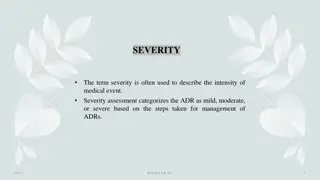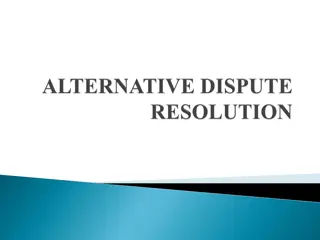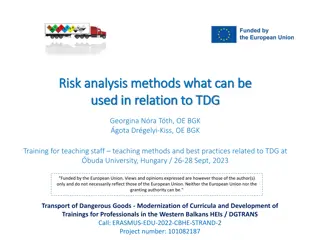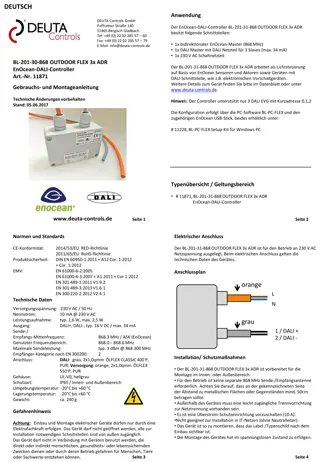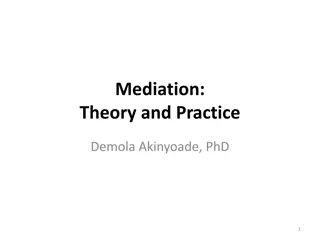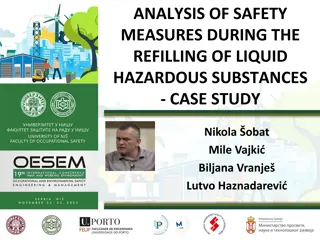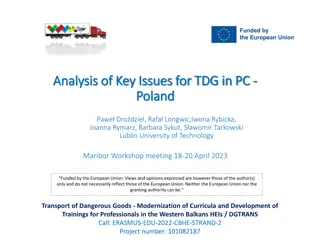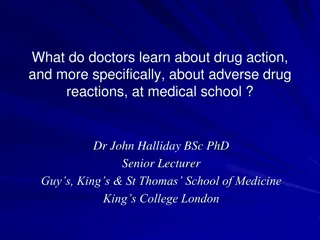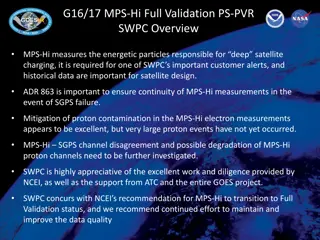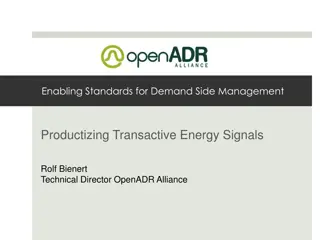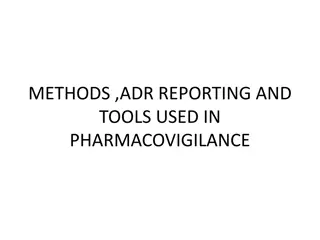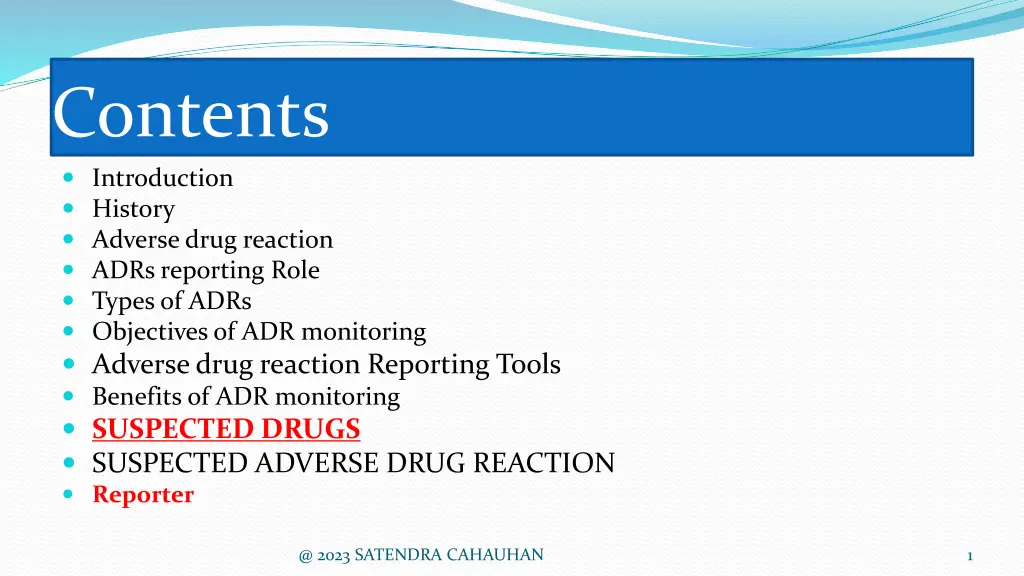
Understanding Adverse Drug Reactions and Reporting Procedures
Learn about adverse drug reactions (ADRs), their history, types, monitoring objectives, and reporting tools. Understand how Pharmacovigilance (PV) programs play a crucial role in detecting and managing ADRs to ensure drug safety.
Download Presentation

Please find below an Image/Link to download the presentation.
The content on the website is provided AS IS for your information and personal use only. It may not be sold, licensed, or shared on other websites without obtaining consent from the author. If you encounter any issues during the download, it is possible that the publisher has removed the file from their server.
You are allowed to download the files provided on this website for personal or commercial use, subject to the condition that they are used lawfully. All files are the property of their respective owners.
The content on the website is provided AS IS for your information and personal use only. It may not be sold, licensed, or shared on other websites without obtaining consent from the author.
E N D
Presentation Transcript
Contents Introduction History Adverse drug reaction ADRs reporting Role Types of ADRs Objectives of ADR monitoring Adverse drug reaction Reporting Tools Benefits of ADR monitoring SUSPECTED DRUGS SUSPECTED ADVERSE DRUG REACTION Reporter @ 2023 SATENDRA CAHAUHAN 1
Introduction Clinical trails study of the drug detects ADR but , the reactions occurs after long duration in a specific population remains undetected. So , ( PV) Pharmacovigilance is a activity which keeps constant watch on the drug throughout its life cycle. In India, IPC and NCC through the CDSCO regulate the PV activity. The PV programme in India have been proposed in 2010.Anyone can report ADR by filling the suspected ADR reporting from available online or offline to the nearest centers in suitable languages. Than , the reported ADRs are collected and processed at the centers in Vigiflow software. The centers detects signals which are reported to CDSCO and WHO. @ 2023 SATENDRA CAHAUHAN 2
Adverse drug reaction According to WHO, an adverse drug reaction defined as, "Any response to a drug which is noxious unwanted effect of drug doses used in human for prophylaxis, diagnosis and therapy". For example, (when drug metabolism is temporarily inhibited by a disorder or another drug). @ 2023 SATENDRA CAHAUHAN 3
History 1957- Thalidomide tragedy. 1968- WHO Programme established with 10 member states for International ADR terminology and drug dictionary. 1969- Definition of Adverse drug reaction. 1978- Operations transferred to the UMC (Uppsala) from WHO(Geneva); setting-up of relational database management system. grading field was added to Vigibase. 1991- On-line WHO database search programme available to national centre. 2001-Start of Vigibase Online project (now Vigiflow). 2010- 100th country joins the WHO Programme for International Drug Monitoring. @ 2023 SATENDRA CAHAUHAN 4
Types of ADRs @ 2023 SATENDRA CAHAUHAN 5
Adverse drug reaction Reporting Tools Adverse drug reactions reporting tools or monitoring is a process of continuously monitoring of undesirable effect suspected to be associated with use of medical products. ADR reporting covers all pharmaceutical products, biological, herbal drugs, cosmetics and medical devices. @ 2023 SATENDRA CAHAUHAN 6
Objectives of ADR monitoring 1. To detect the nature and frequency of ADRs 2.To assist the Drug Regulatory Authority, Public Health Programs, Scientists and Consumer Society to minimize ADRs. 3.Providing updated Drug Safety Information to Health Care Professionals. 5. Dissemination of information by designing proper education program to consumers. 6.To identify risk factors that may predispose, induce or influence the development, severity and incidence of ADRs. @ 2023 SATENDRA CAHAUHAN 9
Benefits of ADR monitoring 1. It caters information about quality and safety of pharmaceuticals products. 2. It initiates risk management plans. 3. It prevent the predictable adverse effects and measuring ADR incidence helps in. 4. It instructs health care team, patients, pharmacists and nurses about adverse drug effects and creates awareness regarding ADRs. @ 2023 SATENDRA CAHAUHAN 10
How To Report ? Use the Suspected Adverse Drug Reaction Reporting from which is available on the official website of IPC ( www.ipc.gov.in ) as well as CDSCO ( www.cdsco.nic.in) @ 2023 SATENDRA CAHAUHAN 11
METHODS OF ADRs Spontaneous Reporting Case series Stimulated reporting Active surveillance Comparative observation studies @ 2023 SATENDRA CAHAUHAN 12
Information required for ADR monitoring 1. Patient Information 2. ADRs Description 3. Information Related to Suspected Drug(s) 4. Information on Management of ADR 5. Information about the reporter @ 2023 SATENDRA CAHAUHAN 13
PATIENT INFORMATION 1.Patient Details Patient name or initials: A reporter should mention the name of the patient or initials of a patient. Age at time of event or date of birth: A reporter must report either the date of birth or age of the patient at the time the event or reaction occurred. Sex: A reporter must mention the gender of the patient. Weight: If known, the weight of the patient should be in kilograms (kg). @ 2023 SATENDRA CAHAUHAN 14
2. Relevant tests/Laboratory data reporter must mention any laboratory data (if available). 3. Other Relevant history reporter must mention any relevant history pertaining to the patient including pre-existing medical conditions. e.g.: Allergies, pregnancy, alcohol use, hepatic or renal dysfunction. SUSPECTED DRUGS; It may be one drug or more than one drug. The details of suspected medications such as the drug name (brand or generic name), manufacturer, batch no / lot no, expiry date, dose used, route used, dates of therapy started and stopped, and indication of use must be provided by the reporter. @ 2023 SATENDRA CAHAUHAN 15
. SUSPECTED ADVERSE DRUG REACTION 1. Describe reaction and any treatment given: A reporter must briefly describe the event in terms of nature, localization etc. For e.g., patient developed rash over upper and lower limbs. The reporter must be also indicate if any treatment is given against the Suspected Adverse Drug Reaction. Reporter must also mention if the suspected drugs was withdrawn or continued .Date of reaction started:- A reporter must the date on which the reaction was first occurred. Date of reaction stopped; If the reaction recovered, the date on which the reaction recovered should be reported . Outcomes: The reporter must tick the outcomes of the event as; Recovered- if the patient has recovered from the event Recovering- if the patient is recovering from the existing adverse event Continuing-if the patient is continuing to have the symptoms of the adverse event which occurred. @ 2023 SATENDRA CAHAUHAN 16
2. Seriousness of the reaction: If any event is serious in nature, a reporter must selected the appropriate reason for seriousness e.g. Death-if the patient died due to the adverse event Hospitalization/prolonged-if the adverse event led to hospitalization or increased the hospital stay of the patient. Life-threatening-if patient was at substantial risk of drying because of the adverse event. Significant Disability-if the adverse event resulted in a substantial disruption of a person's ability to conduct normal life functions. Congenital anomaly-if exposure of drug prior to conception or during pregnancy may have resulted in an adverse outcome in the child. Other medically significant- when the event does not fit the other outcomes, but the event m @ 2023 SATENDRA CAHAUHAN 17
D. OTHER MEDICATIONS; A Reporter should include all the details of concomitant drugs including self medication, Over the Counter medication, herbal remedies with therapy dates(start and stop date). E. REPORTER: Name and Professional address: A reporter must mention his/her name and professional address on the form. The identity of the reporter will be maintained confidential if necessary. Date of report: Mention the date on which he/she reported the adverse event. @ 2023 SATENDRA CAHAUHAN 18
NOTE: For quality reporting, all the above mentioned fields are essential. In case of incomplete information, the reporter must take care that at least mandatory fields are present. Following are the mandatory fields for a valid case report and are marked with asterisk on the form: Patient information: initials, age at onset of reaction, gender. Suspected adverse reaction: A reaction terms, date of onset of reaction. Suspected medication: Drug(s) name, dose and date of therapy started, indication of use, seriousness and outcome. Reporter: Name and address, date of report. @ 2023 SATENDRA CAHAUHAN 19
Role of Pharmacovigilance in ADR monitoring Different study designs are included for proper Pharmacovigilance study: a. Descriptive studies: It is conducted to obtain the rate of outcome of drug use in specific population. b. Analytical studies: Analytical studies are performed to study related outcomes of the exposure to the drugs. c. Observational based study: Usually help to evaluate the effectiveness of the drug in the patients during treatment. @ 2023 SATENDRA CAHAUHAN 20
. SUSPECTED ADVERSE DRUG REACTION @ 2023 SATENDRA CAHAUHAN 21

